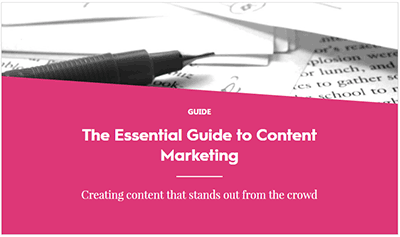Content is king. You’ve probably heard that before. Understanding that you need content for your digital marketing to succeed – whether that’s the content at the core of a multi-channel marketing campaign, or the content that will push your website up the SERPs – is just the first step.
The next, and perhaps more difficult, step is to determine exactly what that content is going to be.
It’s easy to fall into the trap of creating the content that’s easy or comfortable – or the content that you want to see more of on your website. What you need to do instead is create the content that is going to provide you with the greatest benefit.
In this article, I’ll look at some of the ways you can identify content gaps on your website through the use of data and user insight.

Organic traffic weaknesses
Running a report on which of the pages get the most organic traffic on your site can be an effective way of identifying weak points that need some support from a content perspective.
Now, in the vast majority of cases your homepage will be the highest driver of organic traffic. When you look down the list from there, is there anything that jumps out at you as strange?
For example – if you have a range of products, are they receiving a proportion of traffic that reflects their importance to your business? Are your marquee products receiving the lion’s share of the traffic, or is it going to minor offerings?
Trends like this can give you a steer on content production. In this hypothetical situation, the first step would be to review the content on the pages that are under-performing. Are there steps you can take to improve them from an SEO perspective?
Then you need to think about supporting content. It might not just be a weakness in the content on the product or service page itself – the issue might be a lack of content depth.
What is content depth?
Creating a site that sends the right signals to search engines, in terms of the relevance of a page to a specific search query, isn’t just about what you do on the aforementioned page. It’s also about the other content that exists on your site, adding to your sites relevancy through other related keywords and internal links.
That’s what I mean when I talk about content depth. It’s not just about having a well optimised product page, it’s about having supporting content – for example, blogs that discuss the subject in greater detail and then link back to that primary product page.
If your organic traffic review reveals that some of your priority pages are falling behind, then consider making these areas a focus from a content marketing perspective.

Responding to user needs
At Coast Digital, we have a two-pronged approach to making informed marketing decisions. Data is the first part of that approach – identifying content gaps by looking at organic weakness, as outlined above, is an example of a data-driven way to build out a content plan.
The other vital factor to consider is the user – that’s why we always layer in user insight alongside data.
Ultimately, the content you create needs to be valuable to your users. If it’s not, they’re unlikely to read it – and even if they do, it’s unlikely to make a lasting, positive impression on them.
So, how do you layer in user insight to identify content gaps?
Find out what they want to know
A good starting point for identifying content gaps is to find out the kinds of questions your users ask.
The best way to do that is first hand – to reach out to engaged users and ask them if there’s any information they feel is missing from the site, or questions they have that haven’t been fully answered.
If you can’t do that, then the next best thing is to use second hand resources. Engage with the people in your business who speak to users – your sales team, for example. What are the questions they’re always having to answer? What knowledge gaps are the biggest barriers to making a sale?
Another resource is free text areas on your website – such as live chat or a ‘can’t find what you’re looking for’ pop-up. Sifting through this user input for common questions can give you an indication of what users aren’t seeing.
Once you’ve collected this information, it’s time to review what’s on your website. Is there content that answers the questions you’ve identified? If not, it’s time to think about creating it.
If it does exist, then the issue isn’t a content gap – it’s signposting and hierarchy. This is an equally valuable takeaway from this kind of exercise. In this case, review the journey to this content and consider why users aren’t finding it. What steps can you take to get it in front of those people that are asking the question?

CRO your content
Heatmaps and session recordings allow you to combine data and user insight by giving you a quantitative view of what users are interacting with on your website.
This gives you another way to identify content gaps.
Look at where your users are clicking – it’ll often be where you aren’t expecting. If users are regularly clicking on titles or sections of copy, that suggests they’re trying to drill down to get more detail or want more information on that subject.
Again, you may already have content that does this job. In that case, you just need to smooth out the journey and ensure it’s easy for those users to get to it.
If you don’t have that content then it’s time to get writing.
An ongoing approach
With a combination of these three techniques, you can build up a picture of the kind of content that’s missing from your website.
However, this isn’t a ‘one and done’ process. Once you’ve identified content gaps and then written and published the content, it’s time to run through it again.
Once the content has had a little time to bed in and have an effect, it’s time to look again at the metrics that lead to you creating that content.
Has adding this content improved your organic traffic or reduced the frequency of those common user questions?
The success of your previous iteration should then influence your approach the next time round. If it worked, then it’s time to look for more areas where you can make similar improvements. If it didn’t, then you need to analyse why it failed and what you need to do differently.
Make more of your content
Whether you’re looking at ways to make more of the content you already have, or trying to work out what kinds of content you should be creating, it’s always worth looking at ways to get your content working harder.
Our free guide, The Essential Guide to Content Marketing, is full of useful information to help you create a content marketing strategy that delivers the results you need.
Download your free copy today:

